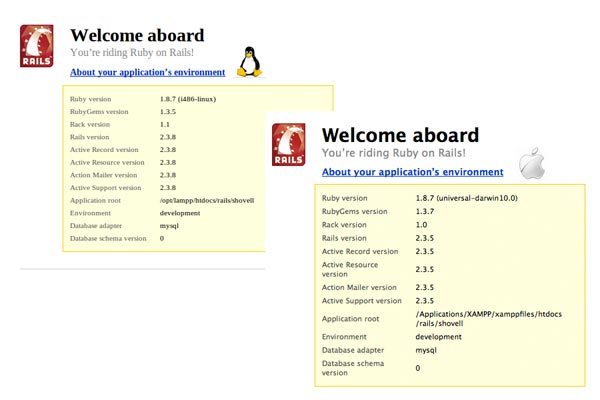- Install Ruby On Rails Mac Sierra
- How Install Ruby
- Install Ruby On Rails Mac Rvm
- Install Ruby On Rails Mac Mojave
- Ruby On Rails Windows
Rails is still very popular these days, and other web frameworks have borrowed many ideas from it. Installing Ruby on Windows PIK. Linux and Mac OS X have a great tool called RVM to manage Ruby versions and gems. There is an alternative for RVM (which is not supported on Windows), PIK. For more reference consult the GitHub page. Stack Overflow for Teams is a private, secure spot for you and your coworkers to find and share information. Get Ruby on Rails in no time Rails is low on dependencies and prides itself on shipping with most everything you need in the box. To get started, just install Ruby, the language, and RubyGems, the package manager. At the time of this writing, rails 4.2 is the current version. If a new version is out you can name the gemset it appropriately. Use the following to install the latest version of rails: $ gem install rails. After it finishes installing, check that rails is installed: $ rails -v. Rails is low on dependencies and prides itself on shipping with most everything you need in the box. To get started, just install Ruby, the language, and RubyGems, the package manager.
by Daniel Kehoe
Last updated 9 November 2016
Install Ruby on Rails 5.0 on macOS, Ubuntu, or Windows. Up-to-date, detailed instructions on how to install the Rails newest release. How to install Rails 5.0, the newest version of Rails.
These installation guides are used by professional developers to configure their working environment for real-world Rails development.
If You Are New to Rails
If you’re new to Rails, see What is Ruby on Rails?, the book Learn Ruby on Rails, and recommendations for a Rails tutorial.
What is the RailsApps Project?
This is an article from the RailsApps project. The RailsApps project provides example applications that developers use as starter apps. Hundreds of developers use the apps, report problems as they arise, and propose solutions. Rails changes frequently; each application is known to work and serves as your personal “reference implementation.” Support for the project comes from people who purchase the Capstone Rails Tutorials.
What’s New in Rails
To stay informed of new releases, subscribe to Peter Cooper’s Ruby Weekly newsletter and follow @ruby_news and @rails_apps on Twitter.
Rails 5.0
Rails 5.0.0 was released June 30, 2016.
Notable additions in Rails 5.0 include an option for an API-only application suitable for use as a backend to JavaScript or mobile applications. Also Action Cable for live features such as chat and notifications.
Learn more about Rails 5.0:
What You Need to Know: Rails 5.0 is the current stable version. Upgrade older projects to Rails 5.0 now. See the article Updating to Rails 5.0 and Upgrading to Rails 5 Beta.
Earlier Releases
For an overview of earlier releases, see a Ruby on Rails Release History.
MacOS
Install Ruby On Rails Mac Sierra
Upgrade to macOS Sierra (10.12) before installing Ruby. MacOS comes with a “system Ruby” pre-installed. MacOS Sierra includes an earlier Ruby version which is not the newest version. For flexibility during development, don’t use the system Ruby. Instead, install Ruby using RVM, the Ruby Version Manager.
See this article for complete instructions:

Before installing Ruby, you’ll need to prepare your computer by installing Apple’s Xcode Command Line Tools.
What You Need to Know: Upgrade to macOS Sierra and install Apple’s Xcode Command Line Tools. Then use RVM to install Ruby.
Ubuntu Linux
On Ubuntu, package managers are available to install Ruby. For Ubuntu Linux, it is best to install RVM, the Ruby Version Manager, to install Ruby and Rails. The package managers are often not up to date. Use RVM instead.
How Install Ruby
Since Rails 3.1, a JavaScript runtime has been needed for development on Ubuntu Linux (it is not needed for macOS or Windows). For development on Ubuntu Linux it is best to install the Node.js server-side JavaScript environment.
See this article for complete instructions:
What You Need to Know: Use RVM to install Ruby and Rails. And install a JavaScript runtime.
Install Ruby On Rails Mac Rvm
Hosted Development
Cloud9 provides a “hosted development environment.” That means the service provides a computer you use from your web browser. Accounts are free for small projects.
The web interface includes a browser-based file manager and text editor, plus a Unix shell with Ruby and Rails pre-installed. Any computer can access the hosted development environment, though you’ll need a broadband connection.
See this article for complete instructions:
Install Ruby On Rails Mac Mojave

What You Need to Know: Use Cloud9 if you don’t want to install Ruby on your computer.
Ruby On Rails Windows
Windows
Developing with Rails on Windows can be painful. Some gems requiring native extensions may be difficult to install. For this reason, most developers use macOS or Ubuntu to develop Rails applications.
Here are your choices for Windows:
- Use the Cloud9 hosted development environment
- Install the Railsbridge Virtual Machine or rails-dev-box
- Use RailsInstaller for Windows as documented in Installing Rails on Windows
Cloud9 is ideal if you have a fast Internet connection. If not, download the Railsbridge Virtual Machine or rails-dev-box for a virtual Linux computer with Ruby 2.0 and Rails 4.0 using Vagrant. The last option, RailsInstaller, is not recommended because it does not provide an up-to-date version of Ruby or Rails. Also, RVM does not run on Windows.
What You Need to Know: Use Cloud9, the Railsbridge Virtual Machine, or switch to macOS or Ubuntu Linux if you can.
Where to Get Help
Your best source for help with problems is Stack Overflow. Your issue may have been encountered and addressed by others.